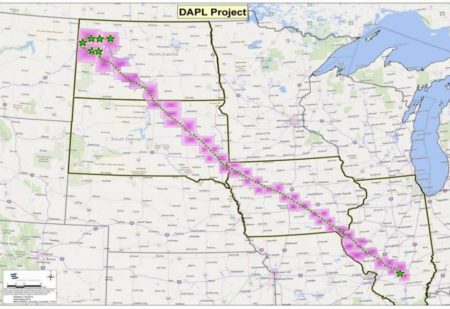November 13, 2019 – In its application to double the capacity of its crude oil pipeline, the operators of Dakota Access, a mid-west U.S. pipeline described “climate change” in the terms appearing in the headline above. I couldn’t agree more and I will tell you why.
Climate change is a confusing term to describe what we have been observing with considerable alarm for the last half-century. It would be far more accurate for us to use phrases like “human-created carbon emissions crisis,” or “atmospheric warming and ocean acidification crisis,” or “sea-level rise crisis.” These are far more descriptive and representative of our current situation.
The Dakota Access, owned by Phillips 66, Enbridge, and Marathon Petroleum, is a $3.8 billion, 1,850 kilometer (1,150-mile) pipeline that crosses through four U.S. states. In August of this year, they submitted an application to Illinois regulators to increase the pipeline’s capacity from 500,000 barrels per day to 1.1 million. It used the words “vague, ambiguous, and undefined,” in discounting concerns about climate change and its impact.
Resistance to the Dakota Access application has come from indigenous and environmental groups bearing a strong resemblance to another pipeline experience north of the U.S. border, the Trans Mountain Expansion (TMX). TMX crosses two provincial borders following the route of an existing pipeline and right-of-way. It has undergone multiple reviews and experienced many legal challenges because like the Dakota Access, TMX plans to increase the amount of oil it is carrying from Alberta’s oil sands to a refinery upgrader and terminal on the British Columbia coastline.
Why would I agree with Dakota Access bellitling of the term “climate change?’ Because it is indeed innocuous. The term first appeared modified as “climatic change” in a 1975 article entitled, “Climatic Change: Are We on the Brink of a Pronounced Global Warming?” The author, a geochemist at Columbia University, used the term rather than what was commonly described as, “inadvertent climate modification” which scientists thought better described what was being observed by those studying industrial emission impacts on the atmosphere.
In 1979, the National Academy of Sciences expressed concerns with a rise in atmospheric carbon dioxide (CO2) and used “climate change” and “global warming” interchangeably in their published articles. Global warming became more popular because of James Hansen, a NASA scientist, who when he testified in front of the U.S. Congress declared that “global warming has reached a level such that we can ascribe with a high degree of confidence a cause and effect relationship between the greenhouse effect and the observed warming.”
In 2001, President George W. Bush used the term “global climate change” in a speech in which he panned the Kyoto Accord while calling for global climate action. Since then we have been talking climate change incessantly.
But here’s the problem. You see, climate change isn’t the same as global warming. The latter is one observable aspect of the former. Climate change could equally apply to global cooling. So by adopting this term we have given climate change deniers and skeptics enough fuel to cast their convoluted theories.
And then the term global warming doesn’t exactly describe the observed phenomenon either. For example:
- Warming hasn’t been uniform tending to be greater at the poles than at the equator.
- Weather patterns have been changing caused by omnipresent heat domes that alter normal atmospheric wind currents.
- Polar vortices have suddenly chilled parts of North America, Europe, and Central Asia, creating record cold temperatures.
- Disrupted weather patterns have led to hurricanes that act in peculiar ways with more of them turning into Category 5s as they cross increasingly warming ocean waters.
- Periodic droughts that characterize Mediterranean climate zones now seem to be turning into megadroughts impacting places like Australia, California, Portugal, Spain, Greece and more.
- Accompanying bone dry conditions with low humidity are wildfire and bushfire outbreaks of an “unprecedented” nature.
- “Blobs” of ocean heat are impacting ecosystems in the Pacific and off the North American west coast that have never previously been observed and bear little resemblance to the natural cycles of the El Nino and La Nina.
- Rising sea-levels are causing sunny day flooding in many low lying coastal communities.
So calling climate change a vague, ambiguous and undefined phrase is perfectly apt, but not for the reasons the Dakota Access applicants have stated. Because what the world is experiencing is anything but vague and ambiguous.
















